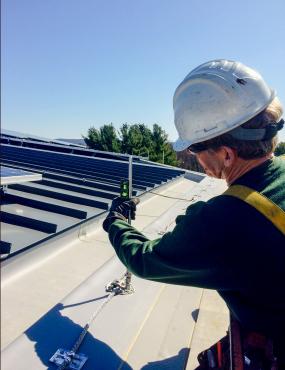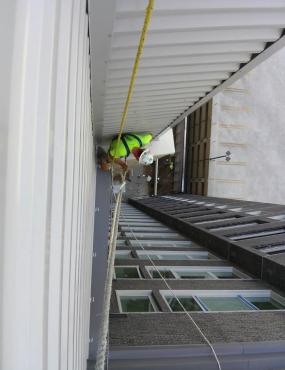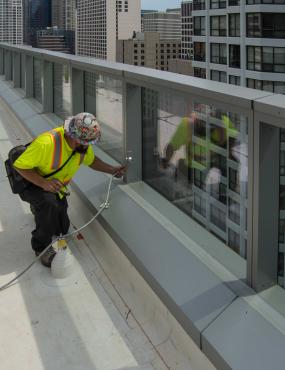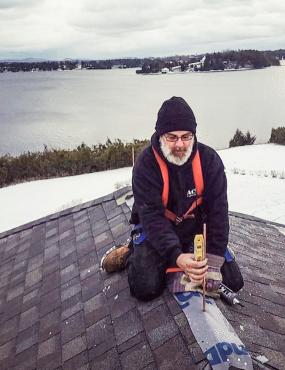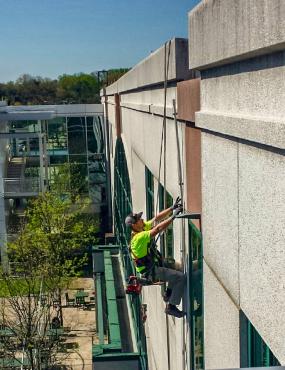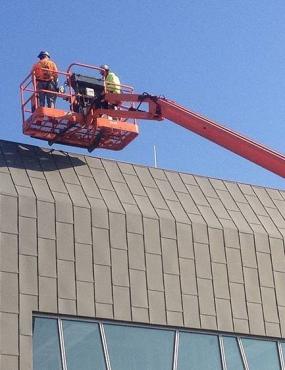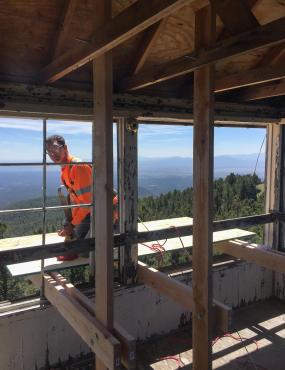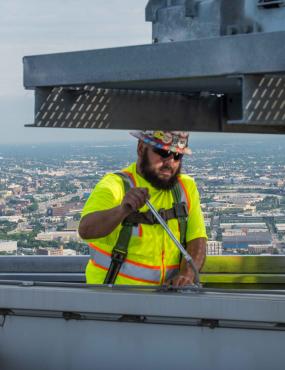Whenever a lightning protection system is specified on a project, these five tips will help ensure the job is executed efficiently and effectively:
1 - Involve an Expert from the Start
Design of lightning protection systems should be delegated to a firm that specializes in lightning protection design and installation and that employs individuals certified by the Lightning Protection Institute (LPI). Communicate with the lightning protection contractor regarding the system design so you both understand the project conditions and can optimize the installation for efficiency. Working with a lightning protection specialist will ensure that the correct lightning protection equipment is used to facilitate ease of installation, ensure compliance with national standards and maintain the projects aesthetics.
Lightning protection contractors are often among the first on the job, laying the grounding system and the last to leave, topping off rooftop equipment. There is a great deal of project coordination required throughout the construction process. Delegating the responsibility for keeping the lightning protection install on schedule to a specialty contractor will keep your headaches to a minimum.
Lightning protection specifications typically require that the lightning protection work be performed by firms that maintain credentials with Underwriters Laboratories and the Lightning Protection Institute. Additionally, most projects require that the completed lightning protection be subject to a third party inspection. Costs to provide such inspections and certifications to firms lacking the appropriate memberships and credentials can be significant.
2 - Compliance Counts
Lightning protection components and installed systems should meet or exceed the requirements for lightning protection established by:
Underwriters Laboratories
UL 96 - Standard for Lightning Protection Components
UL 96A - Standard for Lightning Protection System Installation
National Fire Protection Association
NFPA 780 - Standard for Lightning Protection System Installation
Lightning Protection Institute
LPI 175 - Standard of Practice
ECLE recommends that project planners base lightning protection system designs on the requirements contained in these standards. Lightning protection system specifications should call for adherence to the latest editions of these recognized US consensus standards.
3 - Remodeling and Reroofing Projects
Whenever you encounter lightning protection systems on an existing project, it is important to train your crew to avoid damaging the lightning protection system inadvertently. Removing the hood from a rooftop exhaust fan, for example, can damage the lightning protection connection and may require involving a lightning protection specialist to re-establish connections.
During remodeling and reroofing, a lightning protection specialist should be brought in to oversee removal of the existing lightning protection system components and to make provisions to maintain access to through-roof penetrations, bonding connections and down conductors. Failure to do this could inadvertently make it expensive and maybe even impossible to properly restore the lightning protection system once your work is complete. The lightning protection specialist will make the required provisions to protect new building areas, make required connections to new equipment and systems and to protect any new or relocated services entering the building.
It is also important to find out if the existing system has any certifications in place that your firm could render null and void unwittingly. The lightning protection specialist should return once your work is finished in order to restore the lightning protection and obtain any required inspections and recertifications.
Disruptions to lightning protection systems should be coordinated with building owners and not made when thunderstorms are forecast. Scaffolding may require temporary connection to the lightning protection system if not within the “zone of protection” provided by the system.
4 - Value-Added Upgrade
If the architect/engineer or your client has not included lightning protection in the project specifications, consider recommending a lightning protection system as an added service. Subcontracting a local lightning protection specialist can be surprisingly economical, even with your mark-up for overhead and profit and is an investment that will benefit your client for years to come.
To determine if a building needs protection, use the Simplified Lightning Risk Assessment in NFPA 780 — Standard for the Installation of Lightning Protection Systems. These calculations can be easily performed using this online tool and your lightning protection subcontractor can provide assistance.
5 - Jobsite Safety
When working outdoors or in unenclosed structures, remember: “When Thunder Roars, Go Indoors!”
Employers, supervisors, and workers should understand lightning risks, characteristics, and precautions to minimize workplace hazards. Lightning is unpredictable and can strike outside the heaviest rainfall areas or even up to 10 miles from any rainfall.
Many lightning victims are caught outside during a storm because they did not act promptly to get to a safe place, or they go back outside too soon after a storm has passed. If signs of approaching thunderstorms occur, workers should not begin any task they cannot quickly stop. Proper planning and safe practices can easily increase lightning safety when working outdoors.
Do not wait until the storm is overhead; immediately seek shelter in enclosed buildings or vehicles with metal roofs, and stay sheltered until 30 minutes after storm passes. (Source OSHA Lightning Fact Sheet)
Plan for delays in the construction schedule and in subcontracts. Include lightning in emergency plans and safety training. Be prepared to administer first aid to anyone injured by lightning. More safety tips are at www.weather.gov/safety/lightning-job.
Does your building require lightning protection? Find out now!
Our Partner:

visit www.sls-us.com to learn about their suite of lightning solutions for special applications







